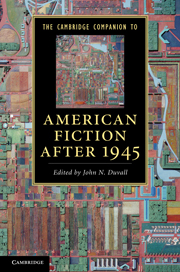Book contents
- Frontmatter
- Introduction: A story of the stories of American fiction after 1945
- PART I POETICS AND GENRES
- PART II HISTORICAL AND CULTURAL CONTEXTS
- PART III MAJOR AUTHORS
- 14 Ralph Ellison
- 15 Flannery O'Connor
- 16 Thomas Pynchon
- 17 Toni Morrison
- 18 Don DeLillo
- Conclusion: Whither American fiction?
- Index
- Cambridge Companions to …
15 - Flannery O'Connor
from PART III - MAJOR AUTHORS
Published online by Cambridge University Press: 28 March 2012
- Frontmatter
- Introduction: A story of the stories of American fiction after 1945
- PART I POETICS AND GENRES
- PART II HISTORICAL AND CULTURAL CONTEXTS
- PART III MAJOR AUTHORS
- 14 Ralph Ellison
- 15 Flannery O'Connor
- 16 Thomas Pynchon
- 17 Toni Morrison
- 18 Don DeLillo
- Conclusion: Whither American fiction?
- Index
- Cambridge Companions to …
Summary
Born March 25, 1925, in Savannah, Georgia, Flannery O'Connor was an only child and a cradle Catholic in one of the most Protestant areas of the United States, the Deep South. Her father's declining health forced O'Connor and her mother to move to the latter's hometown of Milledgeville, Georgia in 1938, where O'Connor began high school as a writer and illustrator for the student newspaper. Three years later her father died, at the age of forty-four, of disseminated lupus, an incurable autoimmune disease. The following year O'Connor entered Georgia State College for Women in Milledgeville, majoring in sociology and English, writing fiction and poetry for the college literary magazine, and contributing satirical cartoons to the yearbook. Her vivid visual sense and gift for caricature would inform her mature fiction, in striking depictions of rural and urban landscapes and deft, often devastating physical portraits of her characters.
After graduating in 1945, she went on to study journalism at the University of Iowa but soon joined the Writers' Workshop, the first program in the country to offer the MFA degree in creative writing. Guided by Workshop director Paul Engle and a series of mentors including John Crowe Ransom, Robert Penn Warren, Andrew Lytle, and Austin Warren – some of the founding figures in American New Criticism – she enjoyed almost instant success as a fiction writer, publishing her first story in 1946 and placing work with Mademoiselle and Sewanee Review the following year.
- Type
- Chapter
- Information
- The Cambridge Companion to American Fiction after 1945 , pp. 207 - 219Publisher: Cambridge University PressPrint publication year: 2011

